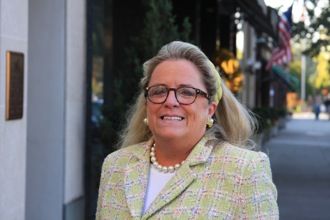From the Mayor: Key Points in Governor Hochul's First State of the State Address

Pictured: Mayor Mary Marvin. Photo by N. Bower
By Mary Marvin, Mayor of Bronxville
Jan. 17, 2024: New York State Governor Kathy Hochul delivered her first State of the State address on January 5.
The Governor outlined nine key points as part of what she called her “New Era for New York Plan.”
The areas of focus include rebuilding the states healthcare economy; protecting public safety by addressing gun violence; investing in New York’s people; making New York’s housing system more affordable, equitable and stable; climate action through green jobs; rebuilding New York’s teacher workforce; investing in the state’s communities and making critical reforms to restore New Yorkers faith in their government.
The Governor did confront population loss since 300,000 New Yorkers left our State last year resulting in the steepest population decline of any state in the nation, making us the leader in out migration for the third straight year.
The following is a synopsis of the Governor’s 274-page address with emphasis on subjects that may have a physical or monetary impact on the Village.
Crime
-Expand college education to all state correctional facilities as well as increasing transitional housing opportunities for the formally incarcerated.
-Expand the definition of hate crimes
-Bail reform does not appear in the address
-Establish a program to curtail the rise in retail thefts by creating a State Police task force to target organized crime activities against stores
-Provide state and local law enforcement with tools necessary to keep residents safe from gun violence, invest in public safety and fund state and local policing gun safety efforts.
-Triple spending for the State Police to trace the purchase of guns used in crimes and fund additional training for police officers on the 2019 “Red Flag Law” which permits the seizure of firearms from people deemed dangerous to themselves or others.
-Promote Jail Jobs program to help those awaiting release from prison to find employment.
-Support the “Clean Slate Act”, which is a proposal helping former inmates and parolees obtain employment and housing by sealing their criminal convictions forcertain felonies after seven years and misdemeanor records after three years.
Healthcare
-Over the course of the next five years, increase the healthcare workforce by 20% by offering free tuition; stipends for graduates who remain in the state and retention bonuses up to $3,000 per healthcare employee.
-A six-point plan to combat infant mortality by expanding access to prenatal care, postpartum depression care and support for newborns.
-No insurance copays for insulin and a ban on hospitals’ ability to sue low-income patients.
-Expand Medicaid coverage to children six and under.
-Expand programs that connect defendants with mental health treatment.
-Address mental health in our schools by focusing on pediatric mental health.
Housing
Program is far less ambitious than last year’s with no unit housing goals set for 2024.
-A new five-year initiative to create 100,000 affordable homes including 10,000 units with supportive services for high-risk populations including runaway youths and formerly incarcerated individuals.
-Fix outdated land use laws that hold back the housing supply.
-Make it easier to convert office buildings into residences and increase the density for some current residential structures.
-No new tenant protection initiatives.
Economy
-More than 2 million homeowners will get $1 billion in property tax rebates in 2024 with low-income households and seniors reaping the biggest benefits.
-Opposed to tax increases, including those on the wealthy (no new taxes to deal with the states projected $4.5 billion deficit in the budget due for adoption by April 1st. Economists estimate the state faces deficits that total $19 billion over the next three years).
(Noted: New York’s income tax of $10.9% on those making more than $2 million is the second highest rate in the country behind California’s 13% rate. New York City millionaires actually top the nation by paying 14.45% in state and city income taxes.)
-Accelerate the phase in of the $1.2 billion in middle class tax cuts affecting 6 million New Yorkers by two years to the current year.
-Increase existing tax credits and create new programs to support food production.
-$100 million in additional tax relief for 195,000 small businesses.
Education
-A push for phonics and literacy education. (New York City is already committed to this approach.)
-Allocate $275 million in state funds with commitments from universities and philanthropists to fund an AI center in upstate New York.
-In the CUNY and SUNY systems, part-time students will be eligible for tuition assistance to help those in the workforce or have families.
-Establish a program called “New York Swims” to build municipal pools in high need areas.
Environment
-Streamline the renewal process for renewable energy infrastructure projects.
-Plant 25 million more trees over the next decade.
-Amend the “Affordable Gas Transition Act”, which would eliminate a subsidy for new gas hookups.
-Increase funding for the states “Clean Water, Clean Air” Environmental Bond Act which goes before voters in November by $1 billion to $4 billion.
-Incorporate $1 billion into the state budget to encourage the purchasing of electric vehicles.
-Boost investment in offshore wind infrastructure.
Integrity of Government
-Limit Governors, Lieutenants Governors, Attorney’s General and Controllers to two consecutive four-year terms.
Government & History Directory
Bronxville is a quaint village (one square mile) located just 16 miles north of midtown Manhattan (roughly 30 minutes on the train) and has a population of approximately 6,500. It is known as a premier community with an excellent public school (K-12) and easy access to Manhattan. Bronxville offers many amenities including an attractive business district, a hospital (Lawrence Hospital), public paddle and tennis courts, fine dining at local restaurants, two private country clubs and a community library.
While the earliest settlers of Bronxville date back to the first half of the 18th century, the history of the modern suburb of Bronxville began in 1890 when William Van Duzer Lawrence purchased a farm and commissioned the architect, William A. Bates, to design a planned community of houses for well-known artists and professionals that became a thriving art colony. This community, now called Lawrence Park, is listed on the National register of Historic Places and many of the homes still have artists’ studios. A neighborhood association within Lawrence Park called “The Hilltop Association” keeps this heritage alive with art shows and other events for neighbors.
Bronxville offers many charming neighborhoods as well as a variety of living options for residents including single family homes, town houses, cooperatives and condominiums. One of the chief benefits of living in “the village” is that your children can attend the Bronxville School.
The Bronxville postal zone (10708, known as “Bronxville PO”) includes the village of Bronxville as well as the Chester Heights section of Eastchester, parts of Tuckahoe and the Lawrence Park West, Cedar Knolls, Armour Villa and Longvale sections of Yonkers. Many of these areas have their own distinct character. For instance, the Armour Villa section has many historic homes and even has its own newsletter called “The Villa Voice” which reports on neighborhood news.
Link to Village of Bronxville One Square Mile Monthly Newsletter
Village of Bronxville Administrative Offices
337-6500
Open 9:00am - 4pm excluding holidays and weekends
Bronxville Police Department
337-0500
Open 24 hours
Bronxville Parking Violations
337-2024
Open 9:00am - 4pm excluding holidays and weekends
Bronxville Fire Deparment
793-6400













